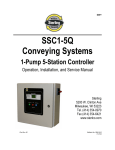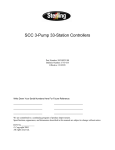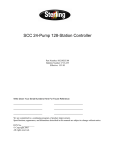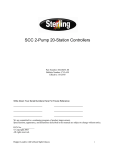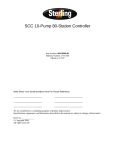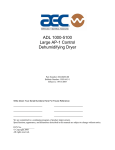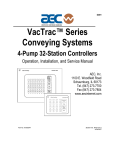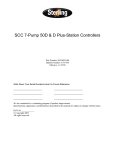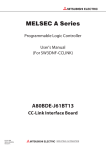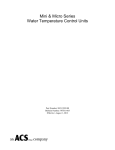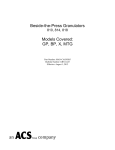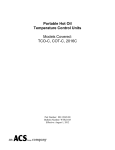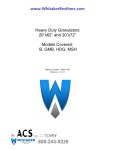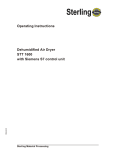Download Sterling Plumbing Paint Sprayer 822.00247.00 User's Manual
Transcript
SCC 1-Pump 9-Station Controller Part Number: 882.00247.00 Bulletin Number: CV3-615 Effective: 10/27/05 Write Down Your Serial Numbers Here For Future Reference: _________________________ _________________________ _________________________ _________________________ _________________________ _________________________ We are committed to a continuing program of product improvement. Specifications, appearance, and dimensions described in this manual are subject to change without notice. DCN No. ____________ © Copyright 2004 All rights reserved. Please note that our address and phone information has changed. Please reference this page for updated contact information. These manuals are obsolete and are provided only for their technical information, data and capacities. Portions of these manuals detailing procedures or precautions in the operation, inspection, maintenance and repair of the products may be inadequate, inaccurate, and/or incomplete and shouldn’t be relied upon. Please contact the ACS Group for more current information about these manuals and their warnings and precautions. Parts and Service Department The ACS Customer Service Group will provide your company with genuine OEM quality parts manufactured to engineering design specifications, which will maximize your equipment’s performance and efficiency. To assist in expediting your phone or fax order, please have the model and serial number of your unit when you contact us. A customer replacement parts list is included in this manual for your convenience. ACS welcomes inquiries on all your parts needs and is dedicated to providing excellent customer service. For immediate assistance, please contact: • North, Central and South America, 8am – 5pm CST +1 (800) 483-3919 for drying, conveying, heating and cooling and automation. For size reduction: +1 (800) 229-2919. North America, emergencies after 5pm CST (847) 439-5855 North America email: [email protected] • Mexico, Central & South America Email: [email protected] • Europe, Middle East & Africa +48 22 390 9720 Email: [email protected] • India +91 21 35329112 Email: [email protected] • Asia/Australia +86 512 8717 1919 Email: [email protected] Sales and Contracting Department Our products are sold by a worldwide network of independent sales representatives. Contact our Sales Department for the name of the sales representative nearest you. Let us install your system. The Contract Department offers any or all of these services: project planning; system packages including drawings; equipment, labor, and construction materials; and union or non-union installations. For assistance with your sales or system contracting needs please Call: North, Central and South America +1 (262) 641-8600 or +1 (847) 273-7700 Monday–Friday, 8am–5pm CST Europe/Middle East/Africa +48 22 390 9720 India +91 21 35329112 Asia/Australia +86 512 8717 1919 Facilities: ACS offers facilities around the world to service you no matter where you are located. For more information, please visit us at www.acscorporate.com United States: ACS Schaumburg – Corporate Offices 1100 E. Woodfield Road Suite 588 Schaumburg, IL 60173 Phone: + 1 847 273 7700 Fax: + 1 847 273 7804 ACS New Berlin – Manufacturing Facility th 2900 S. 160 Street New Berlin, WI 53151 Phone : +1 262 641 8600 Fax: + 1 262 641 8653 Asia/Australia: ACS Suzhou 109 Xingpu Road SIP Suzhou, China 215126 Phone: + 86 8717 1919 Fax: +86 512 8717 1916 Europe/Middle East/Africa: ACS Warsaw Ul. Działkowa 115 02-234 Warszawa Phone: + 48 22 390 9720 Fax: +48 22 390 9724 India ACS India Gat No. 191/1, Sandbhor Complex Mhalunge, Chakan, Tal Khed, Dist. Pune 410501, India Phone: +91 21 35329112 Fax: + 91 20 40147576 Shipping Information Unpacking and Inspection You should inspect your equipment for possible shipping damage. Thoroughly check the equipment for any damage that might have occurred in transit, such as broken or loose wiring and components, loose hardware and mounting screws, etc. In the Event of Shipping Damage According to the contract terms and conditions of the Carrier, the responsibility of the Shipper ends at the time and place of shipment. Notify the transportation company’s local agent if you discover damage Hold the damaged goods and packing material for the examining agent’s inspection. Do not return any goods before the transportation company’s inspection and authorization. File a claim with the transportation company. Substantiate the claim by referring to the agent’s report. A certified copy of our invoice is available upon request. The original Bill of Lading is attached to our original invoice. If the shipment was prepaid, write us for a receipted transportation bill. Advise customer service regarding your wish for assistance and to obtain an RMA (return material authorization) number. If the Shipment is Not Complete Check the packing list as back-ordered items are noted on the packing list. In addition to the equipment itself, you should have: ; Bill of lading ; Packing list ; Operating and Installation packet ; Electrical schematic and panel layout drawings ; Component instruction manuals (if applicable) Re-inspect the container and packing material to see if you missed any smaller items during unpacking. If the Shipment is Not Correct If the shipment is not what you ordered, contact the shipping department immediately. For shipments in the United States and Canada, call 1 (414) 354-0970; for all other countries, call our international desk at (414) 354-0970. Have the order number and item number available. Hold the items until you receive shipping instructions. 1 –Pump 9-Station Controller Chapter 1: Safety ii Returns Do not return any damaged or incorrect items until you receive shipping instructions from the shipping department. Credit Returns Prior to the return of any material authorization must be given by the manufacturer. A RMA number will be assigned for the equipment to be returned. Reason for requesting the return must be given. ALL returned material purchased from the manufacturer returned is subject to 15% ($75.00 minimum) restocking charge. ALL returns are to be shipped prepaid. The invoice number and date or purchase order number and date must be supplied. No credit will be issued for material that is not within the manufacturer’s warranty period and/or in new and unused condition, suitable for resale. Warranty Returns Prior to the return of any material, authorization must be given by the manufacturer. A RMA number will be assigned for the equipment to be returned. Reason for requesting the return must be given. All returns are to be shipped prepaid. The invoice number and date or purchase order number and date must be supplied. After inspecting the material, a replacement or credit will be given, at the manufacturer’s discretion. If the item is found to be defective in materials or workmanship, and it was manufactured by our company, purchased components are covered under their specific warranty terms. 1 –Pump 9-Station Controller Chapter 1: Safety iii Table of Contents CHAPTER 1: SAFETY ...............................................................VI 1-1 1-2 1-3 How to Use This Manual ............................................................................................ vi Safety Symbols Used in this Manual .................................................................... vi Warnings and Precautions ........................................................................................viii Responsibility ............................................................................................................. ix General Responsibility.......................................................................................... ix Operator Responsibility ......................................................................................... x Maintenance Responsibility................................................................................... x Reporting a Safety Defect ..................................................................................... x CHAPTER 2: FUNCTIONAL DESCRIPTION............................ 11 2-1 2-2 2-3 2-4 2-5 Models Covered in This Manual................................................................................ 11 General Description................................................................................................... 11 Standard Features..................................................................................................... 12 Mechanical Features ...........................................................................................12 Electrical Features...............................................................................................12 Controller Features..............................................................................................12 Optional Features...................................................................................................... 13 Safety Devices and Interlocks ................................................................................... 13 Safety Circuit Standards......................................................................................13 Fail Safe Operation .............................................................................................13 Safety Device Lock-Outs .....................................................................................14 CHAPTER 3: INSTALLATION .................................................. 15 3-1 3-2 3-3 Uncrating ................................................................................................................... 15 Mounting the Control Panel....................................................................................... 15 Electrical Connections............................................................................................... 15 Making Control Panel Power Drop Wiring Connections ......................................15 Connecting the Control Panel to Vacuum Hoppers.............................................16 Connecting the Control Panel to the Pump Package ..........................................16 3-4 Setup ........................................................................................................................... 17 Basic Menus and Setup of Controller ..................................................................17 Station Setup.......................................................................................................19 Entering Values Into Controller Fields .................................................................20 Pump Setup.........................................................................................................23 System Setup ......................................................................................................26 CHAPTER 4: OPERATION ....................................................... 28 4-1 4-2 4-3 Overview ................................................................................................................... 28 Starting and Stopping the System............................................................................. 28 Alarms ....................................................................................................................... 28 CHAPTER 5: MAINTENANCE .................................................. 30 1 –Pump 9-Station Controller Chapter 1: Safety iv CHAPTER 6: CONFIGURABLE SETTINGS............................. 31 6-1 6-2 Options for Station Setup .......................................................................................... 31 Options for Pump Setup ............................................................................................ 32 CHAPTER 7: TROUBLESHOOTING ........................................ 33 7-1 7-2 General Troubleshooting........................................................................................... 33 Alarms ....................................................................................................................... 34 Station Alarms .....................................................................................................34 Pump Alarms .......................................................................................................34 CHAPTER 8: APPENDIX .......................................................... 35 8-1 8-2 8-3 8-4 8-5 8-6 Warranty.................................................................................................................... 35 Warranty Specifications.......................................................................................35 Warranty Restrictions ..........................................................................................35 Warranty Liabilities ..............................................................................................36 Customer Responsibilities ...................................................................................36 Optional Components................................................................................................ 36 Drawings and Diagrams ............................................................................................ 37 Spare Parts List......................................................................................................... 37 Controller Identification (Serial Number) Tag ............................................................ 38 Technical Assistance (Contact Information).............................................................. 38 Parts Department ................................................................................................38 Service Department.............................................................................................38 Sales Department................................................................................................38 Contract Department ...........................................................................................38 1 –Pump 9-Station Controller Chapter 1: Safety v Chapter 1: Safety 1-1 How to Use This Manual Use this manual as a guide and reference for installing, operating, and maintaining your equipment. The purpose is to assist you in applying efficient, proven techniques that enhance equipment productivity. This manual covers only light corrective maintenance. No other maintenance should be undertaken without first contacting a service engineer. The Functional Description section outlines models covered, standard features, and optional features. Additional sections within the manual provide instructions for installation, preoperational procedures, operation, preventive maintenance, and corrective maintenance. The Installation chapter includes required data for receiving, unpacking, inspecting, and setup of the equipment. We can also provide the assistance of a factory-trained technician to help train your operator(s) for a nominal charge. This section includes instructions, checks, and adjustments that should be followed before commencing with operation of the equipment. These instructions are intended to supplement standard shop procedures performed at shift, daily, and weekly intervals. The Operation chapter includes a description of electrical and mechanical controls, in addition to information for operating the equipment safely and efficiently. The Maintenance chapter is intended to serve as a source of detailed assembly and disassembly instructions for those areas of the equipment requiring service. Preventive maintenance sections are included to ensure that your equipment provides excellent, long service. The Troubleshooting chapter serves as a guide for identification of most common problems. Potential problems are listed, along with possible causes and related solutions. The Appendix contains technical specifications, drawings, schematics, and parts lists. A spare parts list with part numbers specific to your machine is provided with your shipping paperwork package. Refer to this section for a listing of spare parts for purchase. Have your serial number and model number ready when ordering. Safety Symbols Used in this Manual The following safety alert symbols are used to alert you to potential personal injury hazards. Obey all safety messages that follow these symbols to avoid possible injury or death. Danger! DANGER indicates an imminently hazardous situation which, if not avoided, will result in death or serious injury. Warning! WARNING indicates a potentially hazardous situation or practice which, if not avoided, could result in death or serious injury. Caution! CAUTION indicates a potentially hazardous situation or practice which, if not avoided, may result in minor or moderate injury or in property damage. 1 –Pump 9-Station Controller Chapter 1: Safety vi Controller Safety Tags Tag Description Tag Read Operation & Installation Manual PE 1 –Pump 9-Station Controller Protected Earth Ground Description High Voltage Inside Enclosure Earth Ground Chapter 1: Safety vii 1-2 Warnings and Precautions Our equipment is designed to provide safe and reliable operation when installed and operated within design specifications, following national and local safety codes. This may include, but is not limited to OSHA, NEC, CSA, SPI, and any other local, national and international regulations. To avoid possible personal injury or equipment damage when installing, operating, or maintaining this equipment, use good judgment and follow these safe practices: ; Read and follow these operation and installation instructions when installing, operating, and maintaining this equipment. If these instructions become damaged or unreadable, additional copies are available from the manufacturer. ; Follow all SAFETY CODES. ; Wear SAFETY GLASSES and WORK GLOVES. ; Work only with approved tools and devices. ; Disconnect and/or lock out power before servicing or maintaining the equipment. ; Use care when LOADING, UNLOADING, RIGGING, or MOVING this equipment. ; Operate this equipment within design specifications. ; OPEN, TAG, and LOCK ALL DISCONNECTS before working on equipment. You should remove the fuses and carry them with you. ; Make sure the equipment and components are properly GROUNDED before you switch on power. ; Use EXTEREME CAUTION when working with conveying system. HIGH VACUUM can be dangerous. Keep body parts, tools, clothing, and debris away from vacuum inlets. ; When welding or brazing in or around this equipment, make sure VENTILATION is ADEQUATE. PROTECT adjacent materials from flame or sparks by shielding with sheet metal. An approved FIRE EXTINGUISHER should be close at hand and ready for use if needed. ; Do not restore power until you remove all tools, test equipment, etc., and the equipment and related components are fully reassembled. ; Only PROPERLY TRAINED personnel familiar with the information in this manual should work on this equipment. We have long recognized the importance of safety and have designed and manufactured our equipment with operator safety as a prime consideration. We expect you, as a user, to abide by the foregoing recommendations in order to make operator safety a reality. 1 –Pump 9-Station Controller Chapter 1: Safety viii 1-3 Responsibility These machines are constructed for maximum operator safety when used under standard operating conditions and when recommended instructions are followed in the maintenance and operation of the machine. All personnel engaged in the use of the machine should become familiar with its operation as described in this manual. Proper operation of the machine promotes safety for the operator and all workers in its vicinity. Each individual must take responsibility for observing the prescribed safety rules as outlined. All warning and danger signs must be observed and obeyed. All actual or potential danger areas must be reported to your immediate supervisor. General Responsibility No mater who you are, safety is important. Owners, operators and maintenance personnel must realize that every day, safety is a vital part of their jobs. If your main concern is loss of productivity, remember that production is always affected in a negative way following an accident. The following are some of the ways that accidents can affect your production: • Loss of a skilled operator (temporarily or permanently) • Breakdown of shop morale • Costly damage to equipment • Downtime An effective safety program is responsible and economically sound. Organize a safety committee or group, and hold regular meetings. Promote this group from the management level. Through this group, the safety program can be continually reviewed, maintained, and improved. Keep minutes or a record of the meetings. Hold daily equipment inspections in addition to regular maintenance checks. You will keep your equipment safe for production and exhibit your commitment to safety. Please read and use this manual as a guide to equipment safety. This manual contains safety warnings throughout, specific to each function and point of operation. 1 –Pump 9-Station Controller Chapter 1: Safety ix Operator Responsibility The operator’s responsibility does not end with efficient production. The operator usually has the most daily contact with the equipment and intimately knows its capabilities and limitations. Plant and personnel safety is sometimes forgotten in the desire to meet incentive rates, or through a casual attitude toward machinery formed over a period of months or years. Your employer probably has established a set of safety rules in your workplace. Those rules, this manual, or any other safety information will not keep you from being injured while operating your equipment. Learn and always use safe operation. Cooperate with co-workers to promote safe practices. Immediately report any potentially dangerous situation to your supervisor or appropriate person. Maintenance Responsibility Proper maintenance is essential to safety. If you are a maintenance worker, you must make safety a priority to effectively repair and maintain equipment. Before removing, adjusting, or replacing parts on a machine, remember to turn off all electric supplies and all accessory equipment at the machine, and disconnect and lockout electrical power. Attach warning tags to the disconnect switch. Be sure that all non-current carrying parts are correctly connected to earth ground with an electrical conductor that complies with current codes. Install in accordance with national and local codes. When you have completed the repair or maintenance procedure, check your work and remove your tools, rigging, and handling equipment. Reporting a Safety Defect If you believe that your equipment has a defect that could cause injury, you should immediately discontinue its use and inform the manufacturer. The principle factors that can result in injury are failure to follow proper operating procedures (i.e. lockout/tagout), or failure to maintain a clean and safe working environment. 1 –Pump 9-Station Controller Chapter 1: Safety x Chapter 2: Functional Description 2-1 Models Covered in This Manual This manual provides operation, installation, and maintenance instructions for 1-Pump, 9Station Conveying Controllers. Model numbers are listed on the serial tag. Make sure you know the model and serial number of your equipment before contacting the manufacturer for parts or service. The 1-Pump, 9-Station Conveying Controller is a programmable logic controller, with 24 VDC control circuit, easy-to-use operator interface terminal and optional audible/visual alarm. 2-2 General Description Our material conveying systems create vacuum for the automatic conveying of most freeflowing, dry, pelletized, or granular materials. Material characteristics determine the type of equipment needed to convey the material. A typical use for our equipment is an in-plant distribution system for plastic processing plants. Our central vacuum systems are as varied as the applications they service. The tubing and equipment furnished in our system is designed to convey the material(s) specified at the time of purchase at specific rates and distances. We can advise you on your system capabilities based on system makeup, distance, material, and conveying rates you want. System capacity is directly affected by the pressure drop in the overall system, such as number of material line bends, pipe length, Y-tubes, T-tubes, etc. Use the minimum effective amount of vinyl flex hose to maximize material line efficiency. Keep material lines as straight as possible. Refer to Vacuum Pump Product manual (Part No. A0571050) for installation recommendations. 1 –Pump 9-Station Controller Chapter 2: Functional Description 11 of 38 2-3 Standard Features Mechanical Features Time-fill Capability. A station’s vacuum valve remains open for a specific period of time to allow material to be drawn in. Volume-fill Capability. The vacuum valve will close when material covers the station’s volume-fill proximity sensor or a specific period of time elapses, whichever comes first. Vent Valve. The vent valve extends vacuum pump life by allowing the pump to run unloaded (not drawing a vacuum on a station) for a specified period of time before it shuts off. The alternative, without the vent valve would be to constantly turn the pump on and off whenever a convey cycle is initiated. Closed-Loop Conveying (Dry or Ambient Air). This feature allows material to be conveyed and processed without being contaminated by outside influences (such as moisture, other materials, etc.). Common Purge Valve Output Control for Each Pump. This feature allows any remaining material to be cleaned out of the material lines. Blowback Filter Cleaning. When this feature is enabled, the controller periodically sends compressed air backward through the pump’s air filter to dislodge accumulated dust and debris. Electrical Features • 115/1/60 supply voltage • 24 VDC control voltage • Single-point power and ground connection • Non-fused disconnect switch, lockable • Branch circuit fusing Controller Features • Mitsubishi programmable control with LED display and keypad interface • Monitors Station status and Pump status 1 –Pump 9-Station Controller Chapter 2: Functional Description 12 of 38 2-4 Optional Features Options marked with “*” indicate options that can be factory installed or retrofitted in the field. CE Package for 220/1/50 Operation. Required in Europe and other areas that need 220/1/50 supply voltage. *Remote audible/visual alarm. Alarm light and horn assembly that can be remote mounted and wired into the controller to indicate an alarm condition. 2-5 Safety Devices and Interlocks This section includes information on safety devices and procedures that are inherent to the Controller. This manual is not intended to supersede or alter safety standards established by the user of this equipment. Instead, the material contained in this section is recommended to supplement these procedures in order to provide a safer working environment. At the completion of this section, the operator and maintenance personnel will be able to do the following: • Identify and locate specific safety devices. • Understand the proper use of the safety devices provided. • Describe the function of the safety device. Safety Circuit Standards Safety circuits used in industrial systems protect the operator and maintenance personnel from dangerous energy. They also provide a means of locking out or isolating the energy for servicing equipment. Various agencies have contributed to the establishment of safety standards that apply to the design and manufacture of automated equipment. The Occupational Safety and Health Administration (OSHA) and the Joint Industrial council (JIC) are just a few of the organizations that have joined with the plastics industry to develop safety standards. Every effort has been made to incorporate these standards into the design of the conveying system; however, it is the responsibility of the personnel operating and maintaining the equipment to familiarize themselves with the safety procedures and the proper use of any safety devices. Fail Safe Operation If a safety device or circuit should fail, the design must be such that the failure causes a “Safe” condition. As an example, a safety switch must be a normally open switch. The switch must be held closed with the device it is to protect. If the switch fails, it will go to the open condition, tripping out the safety circuit. At no time should the safety device fail and allow the operation to continue. For example, if a safety switch is guarding a motor, and the safety switch fails, the motor should not be able to run. 1 –Pump 9-Station Controller Chapter 2: Functional Description 13 of 38 Safety Device Lock-Outs Some safety devices disconnect electrical energy from a circuit. The safety devices that are used in this Controller are primarily concerned with electrical power disconnection. WARNING! Always disconnect and lockout all electrical power and pneumatic (i.e. compressed air) sources prior to servicing the 1-Pump, 9-Station Controller. Failure to do so may result in serious injury. No one but the person who installed the lockout may remove it. 1 –Pump 9-Station Controller Chapter 2: Functional Description 14 of 38 Chapter 3: Installation 3-1 Uncrating 1-Pump, 9-Station Controllers are shipped mounted on a skid, enclosed in a plastic wrapper, and contained in a cardboard box. 1. Pry the crating away from the skid. Note: Remove the nails holding the box to the skid and lift the box off carefully; avoiding staples in the 1’ x 4’ wood supports. Cut the steel banding. 2. Use a pry bar to remove the blocks securing the unit to the skid. 3. Lift unit from sides. Use a pry bar if necessary to carefully remove the skid from the unit. 4. Lower slowly. 3-2 Mounting the Control Panel Note: Before you mount the panel, consider how you run wiring to the vacuum hoppers, the filter chamber atmospheric valve (if so equipped) and the pump motor starter(s), vacuum switch(es), and vent valve(s). Mount the panel on a flat, vertical area. It should be a visible area that gives your operator access to the control. The panel requires a low voltage power drop as listed on the serial tag. 3-3 Electrical Connections Refer to local electrical codes, the schematic and connection diagrams supplied with this unit and the serial tag for wiring considerations. Run all wiring in conduit if codes require it. Making Control Panel Power Drop Wiring Connections Hardwire the input power at 115/1/60 VAC or 220V/1/50 VAC, depending on the specifications, which are located on the Control Panel Serial Tag. The main power switch is located on the front of the enclosure. Caution! We recommend that you protect PLC memory by providing the control panel with a dedicated circuit, a true earth ground, and a spike/surge protector. 1 –Pump 9-Station Controller Chapter 3: Installation 15 of 38 Connecting the Control Panel to Vacuum Hoppers Note: Wire size depends on control voltage, distance, number of vacuum hoppers, and the number of wires in each raceway. Consult a qualified electrician. 1. On 24 VDC control voltage systems, run a common +24 VDC wire and a common 0 (zero) VDC wire from the controller to each vacuum hopper in the system. 2. On all systems, run two wires to each vacuum hopper: one each from the controller to the Bin-Full switch (LS) and to the Atmospheric/Sequence-T solenoid (SOL) valve. 3. Properly ground each hopper to reduce static build up generated by material conveying. Connecting the Control Panel to the Pump Package 1. Wire the pump package motor starter coil (M) to the terminal provided in the control panel enclosure. 2. Wire the pump package vacuum relief valve solenoid (10 SOL) to the terminal provided in the control panel enclosure. 3. Wire the pump package vacuum switch (VS) to the terminal located in the control panel enclosure. 4. On vacuum pumps with implosion filter cleaning, wire the clearing valve (11 SOL) and sealing valve (12 SOL) solenoids. 5. On vacuum pumps with compressed air filter cleaning, wire the blowback solenoid (11 SOL) to the terminal located in the control panel enclosure. 6. Wire the pump package motor overload to the terminal provided in the control panel enclosure. 7. On 24 VDC control voltage systems, run a common +24 VDC wire and a common 0 (zero) VDC wire from the controller to each pump package in the system. 1 –Pump 9-Station Controller Chapter 3: Installation 16 of 38 3-4 Setup This section provides the procedures for configuring your 1-pump, 9-station controller. Configuration of your controller includes setting the number of stations and pumps, setting variables such as convey time and blow-back intervals. We recommend that you carry out these procedures in the order given here. Note: Before carrying out these procedures, install all equipment as described in this section and in the Conveying Systems manual. Basic Menus and Setup of Controller Once power has been applied to a properly installed system, turn the disconnect switch to the ON position. The controller will display the title screen (Shown below) after the initial Mitsubishi controller serial number screen has been displayed. Figure 1: Title Screen The operator will then have to press the F6 key to enter the Main Menu (Figure 2). Figure 2: Main Menu Screen The Main Menu will provide access to the following controller functions and features: • Turning the system On and Off • Viewing the status of the system • Setting station features • Setting pump features • Setting system features Activating and Deactivating the System To activate or deactivate the system, press the F1 key on the controller keypad. Note: The system can also be turned On and Off by pressing F1 in additional screens which will be mentioned later in this manual. 1 –Pump 9-Station Controller Chapter 3: Installation 17 of 38 Viewing System Status The station and pump status screen (Shown below) can be viewed by pressing the F2 key on the controller keypad. Figure 3: Status Screen This screen will show whether stations 1-9 and the pump (shown in the bottom right of the screen- “P1”) are Ready or Offline. For a list of additional station and pump status names and their description which may be displayed on this screen, see below. Figure 4: Station Status Names & Descriptions Name OFFLINE READY DEMAND CONVEY UNLOAD NOCONV PURGE HIVAC Description Station is disabled or not installed. Normal idle condition. Station is in demand, waiting to convey. Convey to station is in progress. Convey is complete, station is now unloading. Station has a no convey alarm. Station convey is complete – lines are being purged. High vacuum alarm. Figure 5: Pump Status Names & Descriptions Name OFFLINE READY IDLE CONVEY HIVAC PMP FLT GEN FLT FLTR CAN Note: Description Pump is disabled. Pump is idle and off. Pump is idle and running. Pump is conveying or purging. High vacuum alarm. Pump Verify alarm. User input alarm. Filter can limit switch alarm. Pressing F1 while this screen is active will turn On or Off the conveying system. Press F6 to return to the Main Menu. 1 –Pump 9-Station Controller Chapter 3: Installation 18 of 38 Station Setup To set the station settings and features of your conveying system, press the F4 key on the controller keypad while in the Main Menu screen. The initial (of three) Station Setup screen will be shown (below): Figure 6: Initial Station Setup Screen This screen will allow you to set the following features: • Convey time - Convey time is the length of time the station’s vacuum valve remains open to allow material to be drawn in. (For a volume-fill station, the valve closes when material covers the station’s volume-fill proximity sensor or this time elapses, whichever comes first.) This setting is shown in seconds and the duration can be set from 1-999. • Last Convey – This screen is meant for display only and shows the duration time (in seconds) of the most recent convey. • Unload Time - This is the length of time allowed for material to drain from the station into its receiver. The unload duration is shown in seconds and can be set from 1-999. Note: See the next page for instructions on entering numerical data into the controller. Once the values have been entered for the settings listed above, the operator can choose to do the following: • Turn this station On or Off (Press F1 while in this screen) • Enter additional values for this station in the second setup screen (Press F3). • Enter the same values listed above for the next station in sequence (Press F5). • Return to the Main Menu (Press F6). 1 –Pump 9-Station Controller Chapter 3: Installation 19 of 38 Entering Values Into Controller Fields When it is necessary to change the settings for a particular feature, you will need to do the following: 1. Use the arrow keys to select the value. 2. Select the value in the field to be changed by pressing the SET key. 3. Press the numbers you want to enter into the field from the numeric keypad (Shown below). 4. Press the green ENT (Enter) key to enter those values or the red ESC (Escape) key to return the values back to their original setting. 5. Use the arrow keys to scroll up or down to set the values in the next or previous field. Note: Values entered into the fields must be set into the controller using the ENT key before moving on to the next field or data will be lost. Figure 7: Controller Keypad 1 –Pump 9-Station Controller Chapter 3: Installation 20 of 38 Second Station Setup Screen Once the settings have been entered into the initial Station Setup Screen, press F3 to access the next set of configurable station settings. The second station setup screen (Figure 8) will be shown. Figure 8: Second Station Setup Screen This screen will allow you to set/activate the following features: • Purge Time – this is the length of time allowed for material to be cleaned out of the system. Purge time duration is displayed in seconds and can be set from 1-999. • Purge F2- this allows you to enable or disable the purge cycle by pressing the F2 button on the keypad. • CL Loop F4 – this allows you to enable or disable the closed loop feature for this station by pressing the F4 button on the keypad. Once the values and settings have been entered, the operator can choose to do the following: • Enter the settings from this screen for the next station in sequence (Press F5 while in this screen) • Enter additional settings for this station in the third setup screen (Press F3). • Return to the Main Menu (Press F6). 1 –Pump 9-Station Controller Chapter 3: Installation 21 of 38 Third Station Setup Screen Once the settings have been entered into the second Station Setup Screen, press F3 to access the next set of configurable station settings. The third station setup screen (Figure 9) will be shown. Figure 9: Third Station Setup Screen This screen will allow you to set/activate the following features: • No CNVY F2 – This feature allows you to enable or disable the station no convey alarm. • No Conveys – This is the number of times the system will allow unsuccessful conveys before setting off an alarm. This number can be set between 0 and 99. • SP CNVY F4 – Pressing F4 allows the operator to turn the Special Convey feature On or Off. Once the values and settings have been entered, the operator can choose to do the following: • Return to the Main Menu (Press F6). • Return to the Initial Station Setup Screen (Press F3). • Enter these features for the next station in sequence (Press F5 while in this screen) Note: Repeat the steps listed in the previous pages to set the features and settings for each station in your system. 1 –Pump 9-Station Controller Chapter 3: Installation 22 of 38 Pump Setup To set the pump settings and features of your conveying system, press the F5 key on the controller keypad while in the Main Menu screen. The initial (of three) Pump Setup screen will be shown (below): Figure 10: Initial Pump Setup Screen This screen will allow you to set the following features: • FC ENABLE F2 – Pressing F2 allows you to enable or disable the filter cleaning feature. • FC TYPE F5- This feature allows you to toggle between blowback and implosion cleaning (Press F5). This setting must match the equipment that was installed in your system. • CNVYS/CLEAN – This is the number of convey cycles allowed between filter cleanings. This value can be set between 1 and 99. Once the values have been entered for the settings listed above, the operator can choose to do the following: • Turn the pump On or Off (Press F1 while in this screen) • Enter additional values for this pump in the second setup screen (Press F3). • Return to the Main Menu (Press F6). 1 –Pump 9-Station Controller Chapter 3: Installation 23 of 38 Second Pump Setup Screen Once the settings have been entered into the initial Pump Setup Screen, press F3 to access the next set of configurable pump settings. The second pump setup screen (Figure 11) will be shown. Figure 11: Second Pump Setup Screen This screen will allow you to set the following features: • CLEAN PULSES – This is the number of blowback/implosion pulses allowed during filter cleaning. This value can be set between 1 and 99. • ON PULSE- This feature allows you to set the amount of time that the blowback/implosion pulse will remain on during filter cleaning. This value can be set between 0.1 and 99.9 seconds. • OFF PULSE- This feature allows you to set the amount of time in between blowback/implosion pulses during filter cleaning. This value can be set between 0.1 and 99.9 seconds. Once the values have been entered for the settings listed above, the operator can choose to do the following: • Turn the pump On or Off (Press F1 while in this screen) • Enter additional values for this pump in the third setup screen (Press F3). • Return to the Main Menu (Press F6). 1 –Pump 9-Station Controller Chapter 3: Installation 24 of 38 Third Pump Setup Screen Once the settings have been entered into the second Pump Setup Screen, press F3 to access the next set of configurable pump settings. The third pump setup screen (Figure 12) will be shown. Figure 12: Third Pump Setup Screen This screen will allow you to set the following features: • RAMP UP TIME- This is the delay in seconds from when the pump starts till the conveying system starts. This value can be entered between 1 and 99. • RAMP DN TIME- This is the delay in seconds from when the pump stops till the next time the pump starts again. This value can be entered between 1 and 99. Note: There must be sufficient time for the motor to completely stop before starting again. • IDLE TIME- This is the delay in seconds from when the pump last conveyed material till the pump stops. This value can be entered between 1 and 999. Once the values have been entered for the settings listed above, the operator can choose to do the following: • Turn the pump On or Off (Press F1 while in this screen) • Return to the initial setup screen to review settings or make additional changes (Press F3). • Return to the Main Menu (Press F6). 1 –Pump 9-Station Controller Chapter 3: Installation 25 of 38 System Setup To set the system settings and features of your conveying system, press the F6 key on the controller keypad while in the Main Menu screen. The initial (of three) System Setup screen will be shown (below): Figure 13: Initial System Setup Screen This screen will allow you to set the following features: • INSTALLED HOPPERS – This will allow you to input the number of stations present in the system. Values can be entered between 0 and 9 total hoppers. • HI VAC DEBOUNCE- This is the minimum amount of time (in seconds) that a High Vacuum Signal will occur before being recognized by the system. This value can be entered between 0.1 and 9.9. • HI VAC DELAY- This is the amount of time (in seconds) before the High Vacuum Alarm will occur once a High Vacuum Signal has been recognized. This value can be set between 2.0 and 9.9. Once the values have been entered for the settings listed above, the operator can choose to do the following: • Turn the system On or Off (Press F1 while in this screen) • Enter additional values for the system in the second setup screen (Press F3). • Return to the Main Menu (Press F6). 1 –Pump 9-Station Controller Chapter 3: Installation 26 of 38 Second System Setup Screen Once the settings have been entered into the initial System Setup Screen, press F3 to access the next set of configurable system settings. The second system setup screen (Figure 14) will be shown. Figure 14: Second System Setup Screen This screen will allow you to set the following feature: • Station Demand Debounce- This is the minimum amount of time in seconds before the demand signal is recognized by the system. Values can be set between 0.5 and 2.0. Once the values have been entered for the settings listed above, the operator can choose to do the following: • Press the F5 key once while in this screen to view and set the Debounce settings for Stations 4-6. If the F5 key is pressed again while in the Debounce settings for Stations 4-6, the screen will display and allow the operator to set the Debounce settings for Stations 7-9. • Return to the Main Menu (Press F6). Third System Setup Screen Once the Debounce settings have been entered into the second System Setup Screen, press F3 to access the next system setting. The third (really the fifth) system setup screen (Figure 15) will be shown. Figure 15: Third System Setup Screen This screen will allow you to set the Alarm Silence Duration. This feature is the length of time (in minutes) before an alarm horn will reactivate while in an alarm condition. The value can be set between 1 and 50. Once the value has been entered for the setting listed above, the operator can choose to do the following: • Return to the Initial System Setup Screen (Press F5). • Return to the Main Menu (Press F6). 1 –Pump 9-Station Controller Chapter 3: Installation 27 of 38 Chapter 4: Operation 4-1 Overview Your 1-pump, 9-station controller electrically controls valves and solenoids to convey material from a central location to individual stations as needed. The controller senses demands for material at the stations and responds to the demands in a timely fashion. This section provides the procedures necessary for using your controller. Note: 4-2 Before you carry out any of the procedures in this chapter, the system must be set up as described in Chapter 3. Starting and Stopping the System 1. Press F1 to start the conveying system. The controller will display “F1 SYS ON” in the upper left corner of the Main Menu screen. Note: The conveying system can also be activated by pressing the F1 key when in the Status screen. The controller will display “F1 SYS ON”in the middle of the bottom of the screen. Once the system has been started, each active station is polled in sequence for a demand signal. The convey sequence upon initiation, will continue until the set convey time has elapsed or the demand signal stops, whichever happens first. If the Special Timed Convey feature is enabled, conveying will continue until the convey time has elapsed. (Once station dump delay has been initiated during the convey sequence, a new demand signal will be ignored.) If the blowback sequence begins immediately following the convey sequence, the sequence valve will remain open throughout the blowback sequence. 2. To stop conveying, press F1 again when in the Main Menu or Status screen. The controller will display “F1 SYS OFF.” 4-3 Alarms No Convey If no convey is enabled and the station conveys the specified number of times unsuccessfully, the alarm horn/light will activate. The status for that station will display “NO CNVY.” If the station is currently in convey or unload, the status will alternate between “NO CNVY” and “CONVEY” or “UNLOAD.” Pressing F2 while the status screen is displayed will silence the alarm. The status screen will continue to show “NO CNVY” until a successful convey occurs. High Vacuum If a high vacuum condition is detected during the convey sequence, the alarm horn/light will activate. The status for the affected station will display “HI VAC.” If the station is currently in convey or unload, the status will alternate between “HI VAC” and “CONVEY” or “UNLOAD.” Pressing F2 while the status screen is displayed will silence the alarm. The status screen will continue to show “HI VAC” until a convey occurs where no high vacuum condition is sensed. 1 –Pump 9-Station Controller Chapter 4: Operation 28 of 38 Pump Fault If the pump verify signal is not present after the pump is started, the alarm horn/light will activate. The pump will be stopped and set to an offline condition. The Status screen will display “PMP FLT.” Pressing F2 while the status screen is displayed will silence the alarm. Filter Can If the filter can limit switch signal is not present after the pump is started, the alarm horn/light will activate. The Status screen will display “FLTR CAN”. Pressing F2 while the status screen is displayed will silence the alarm. General Fault If the general fault signal is present after the pump is started, the alarm horn/light will activate. The pump will be stopped and set to an offline condition. The Status screen will display “GEN FLT.” Pressing F2 while the status screen is displayed will silence the alarm. All Faults If after silencing an alarm, the condition remains beyond the time specified for ALARM SILENCE DURATION, the alarm horn/light will reactivate. Pressing F2 from the status screen will silence the alarm. 1 –Pump 9-Station Controller Chapter 4: Operation 29 of 38 Chapter 5: Maintenance No Periodic maintenance is required on this unit. 1 –Pump 9-Station Controller Chapter 5: Maintenance 30 of 38 Chapter 6: Configurable Settings This section describes the proper setup of the 1-pump, 9-station control system parameters. These parameters are operator changeable; however, these items should require setup only during the initial installation. Only authorized personnel should change them. Many of the variables and setup parameters have been preset at the factory and do not need to be changed. However, this section of the manual will address all of the setup parameters that were available at the time of printing. The purpose of this is to familiarize the reader with all the setup parameters and their usage. 6-1 Options for Station Setup Name Description Conveying Components Convey time Unload Time No conveys Default Length of time the station’s vacuum valve remains open to allow material to be drawn in. (For a volume-fill station, the valve closes when material covers the station’s volume-fill proximity sensor or this time elapses, whichever comes first.) 15 sec. Adjust this value to match the actual time needed to fill the station. To disable a station, set the convey time to Ø (zero). Length of time allowed for material to drain from the station into the receiver. The controller will not attempt to deliver more material to the station until this time has elapsed. Adjust this value to match the actual time needed to drain the station. If it is set too short, the controller may attempt to refill the station before it is empty, causing material to back up and/or underusing the station’s capacity. If it is set too long, the system may be unable to keep up with your equipment’s demand for material. DO NOT SET TO “Ø”. The controller issues a “no convey” alarm if it has repeatedly attempted to convey material to the station but the flapper never opened during the dump delay. (The number of attempts is controlled by this setting.) The setting for this option depends on (a) how much material your injection mold uses to make each part compared with the capacity of the receiver and (b) how important it is to keep your injection mold from running out of material and shutting down. A higher setting will give you fewer alarms, at the risk of emptying the receiver without warning. A lower setting will give more frequent alarms, at the risk of disrupting operations unnecessarily. DO NOT SET TO “Ø”. 1 –Pump 9-Station Controller Chapter 6: Configurable Settings 10 sec. 3 31 of 38 6-2 Options for Pump Setup The ramp time represents the amount of time it takes for the vacuum blower to come up to full speed once it has been turned on. The ramp down time represents the amount of time it takes the blower to stop once it has been turned off. The ramp up time lets the blower reach full speed unloaded. When the ramp up time is reached, the vent valve will open and allow the pump to draw a vacuum on the main vacuum line. This in turn will open the receiver sequence valve connected to the main vacuum line and allow material to be drawn into the vacuum receiver. The ramp down time allows the vacuum blower to come to a full stop before it can be started again. This prevents the blower motor from becoming a generator and blowing fuses. Name Pump Settings Idle Time Ramp Up Time Ramp Down Time Cnvys/Clean On Pulse Description Default Length of time the pump continues to run unloaded without demand from any station. After this time has elapsed, the pump shuts down to save power and to prevent wear on the pump. Adjust this setting to fit the needs of your facility in trading off the savings against the costs associated with waiting for a pump to start up when there is a demand for material. This feature specifies the time (in seconds) allowed for the pump motor to reach operating speed. This feature specifies the time (in seconds) allowed for the pump motor to come to a complete stop. When this option is enabled, the controller periodically sends compressed air backward through the pump’s air filter to dislodge accumulated dust and debris. Enable this option if and only if the pump has the equipment for compressed-air filter cleaning. Set to Ø to Disable Blowback. Number of conveying cycles to stations between filter cleanings. Adjust this setting based on experience. The more dust and debris in your material line, the smaller this number needs to be. Tenths of seconds that the air pulse remains on for each cleaning pulse during filter cleaning. If blow-back is not working as desired, the service department may ask you to change this setting. Off Pulse Tenths of seconds between air pulses during filter cleaning. If blow-back is not working as desired, the service department may ask you to change this setting. Numbler of cleaning pulses (No. Pulses) Clean Pulses Number of pulses of compressed air sent through the pump’s filter during cleaning. If blow-back is not working as desired, the service department may ask you to change this setting. Set to Ø to Disable Blowback. Vacuum or Implosion – Must match equipment. FC Type 1 –Pump 9-Station Controller Chapter 6: Configurable Settings 45 sec. 5 sec. 5 sec. enabled 5 1.6 sec. 0.8 sec. 1 32 of 38 Chapter 7: Troubleshooting 7-1 General Troubleshooting Problem The control panel doesn’t light up at all A pump package doesn’t run, even though it is on-line and its indicator is lit. A vacuum receiver is being bypassed in the loading cycle. Vacuum receivers are overfilling. Possible Cause The control panel is not turned on. Solution Turn on the control panel. The external disconnect (recommended) in the dedicated circuit is open (off). Fuse/circuit breaker in the power drop is blown/tripped. Control power switch is broken. The motor overload has tripped. Close the switch (on). Main fuse in power drop or optional fused disconnect has blown. Motor contact is faulty. The vacuum receiver is off-line. The convey time for the vacuum receiver is set to zero. The field-installed station bypass switch is simulating a Bin Full condition. The field-installed station bypass switch is bad or mis-wired. The vacuum receiver was assigned to the wrong pump during setup. Conveying times are too long (Time Fill Mode only). Maximum conveying times are too long, and the PLC does not recognize the Vacuum Receiver Full Proximity Switch(es). 1 –Pump 9-Station Controller Replace/reset. Replace. Reset the overload and check the motor for the proper amp draw on tag. Replace the fuse. Repair or replace as required. Use the controller to put the vacuum receiver on-line. Use the controller to enter a longer convey time. Normal operation. Set the switch so the vacuum receiver is back in the loading sequence. Repair, replace, or re-wire. Repeat the setup procedure. Time the vacuum receiver (s) during loading, and set the conveying times to a few seconds less. Check proximity sensors for proper operation and proper wiring to the PLC. Repair as needed. Reset the conveying times to a reasonable value, and adjust as needed. Chapter 7: Troubleshooting 33 of 38 7-2 Alarms The format for all station alarms is “Station n [alarm text],” for example, “Station 9 receiver low level.” The format for all pump alarms is “Pump n [alarm text].” Any alarm that does not start with “Station” or “Pump” is a system alarm. The following tables list all alarms alphabetically, together with possible causes. A “critical” alarm is one that causes the affected device to stop. Note: You can also see a list of alarms and their causes in the controller’s online help. To display this information, touch the color key of statuses in the upper right-hand corner of either the “Station Status” or the “Pump Status” screen, or touch Help at any other screen. When you are finished reviewing the help, touch Return. Station Alarms Alarm message High vacuum No convey Possible cause Material line is blocked. Vacuum line is blocked. Convey time is too long (time-fill station only). Sequence valve has malfunctioned. Vacuum switch has malfunctioned. Note: After you have corrected the cause of this alarm, the alarm will be cleared when the controller has conveyed a full load to this station. Material container is empty. Material line is disconnected from material source. Vacuum line is disconnected from station. Take-off compartment is not adjusted properly. Convey time is too short. Note: As a stopgap measure, you can disable the “no convey” alarm for this station until the problem can be remedied. Pump Alarms Alarm message Pump failure (Critical) 1 –Pump 9-Station Controller Possible cause Circuit breaker or overload protector has tripped. Contactor has malfunctioned. Chapter 7: Troubleshooting 34 of 38 Chapter 8: Appendix 8-1 Warranty Unless otherwise specified, this product includes a Standard ONE YEAR PARTS AND LABOR WARRANTY. Warranty Specifications The manufacturer hereby expressly warrants all equipment manufactured by it to be free from defects in workmanship and material when used under recommended conditions, as set forth in the operating manuals for such equipment. THE FOREGOING EXPRESS WARRANTY IS EXCLUSIVE AND IN LIEU OF ALL OTHER WARRANTIES, GUARANTEES, AGREEMENTS, AND SIMILAR OBLIGATIONS OF THE COMPANY AND/OR MANUFACTURER (UNLESS OTHERWISE SPECIFIED IN THE SPECIFIC PRICE PAGE OR LIMITED BY THE MANUFACTURERS’ WARRANTY FOR PARTS). The Company’s obligation is limited to repair or replace FOB the factory any parts that are returned, prepaid, within one year of equipment shipment to the original purchaser, and which in the Company’s opinion, are defective. Any replacement part assumes the unused portion of this warranty. Warranty Restrictions This parts warranty does not cover any labor charges for replacement of parts, adjustment repairs, or any other work. This warranty does not apply to any equipment which, in the Company’s opinion, has been subjected to misuse, negligence, or operation in excess of recommended limits, including freezing or which has been repaired or altered without the Company’s express authorization. If the serial number has been defaced or removed from the component, the warranty on that component is void. Defective parts become the property of the warrantor and are to be returned immediately, without any further use or handling. 1 –Pump 9-Station Controller Chapter 8: Appendix 35 of 38 Warranty Liabilities THE COMPANY EXPRESSLY DISCLAIMS ANY AND ALL LIABILITY FOR ANY SPECIAL, CONSEQUENTIAL OR INCIDENTAL DAMAGES OR EXPENSES THAT RESULT FROM THE USE OF THIS PRODUCT. Some states do not allow the exclusion or limitation of special, consequential or incidental damages, so the above limitation may not apply to you. The Company’s obligation for parts not furnished as components of its manufactured equipment is limited to the warranty of the manufacturers of said parts. The company neither assumes nor authorizes any other persons to assume for it any liability in connection with the sale of its equipment not expressed in this warranty. No person, agent, manufacturer, distributor, dealer, installer or company is authorized to change, modify or extend the terms of this warranty in any manner whatsoever. The time within which an action must be commenced to enforce any obligation of the Company’s arising under this warranty, or under any statute or law of the United States or any state thereof, is hereby limited to the duration of this warranty. Some states do not permit this limitation, so the above may not apply to you. This warranty gives you specific legal rights and you may also have other rights which vary from state to state. For transactions involving the potential applicability of international law or that of a foreign country, this warranty policy and the procedures hereunder shall be governed by applicable federal and state law, but not by the United Nations Convention on Contracts for the Sale of Goods. Customer Responsibilities Any sales, use, or other tax incident to the replacement of parts under this warranty is the responsibility of the purchaser. 8-2 Optional Components The following is a list of options that your controller may be equipped with: CE Package for 220/1/50 Operation. Required in Europe and other areas that need 220/1/50 supply voltage. Remote audible/visual alarm. Alarm light and horn assembly that can be remote mounted and wired into the controller to indicate an alarm condition. 1 –Pump 9-Station Controller Chapter 8: Appendix 36 of 38 8-3 Drawings and Diagrams Figure 1: 1-Pump 9 Station Controller 16” 3.30” 6” Display 4.69” 16” * Depth dimension is 8” Also, review electrical drawings supplied in the packet with the manual. 8-4 Spare Parts List Quantity 2 2 1 1 1 1 2 1 1 –Pump 9-Station Controller Part Number A0569870 A0569859 A0540997 A0542210 A0544790 A0542203 A0542200 A0542207 Description Relay Air Grill with Filter Fuse, MDL –1 Fuse, MDL – 5 Fuse, MDL – 8 Fuse, MDL – 2 Fuse, MDL – 1.5 Fuse, MDL - 3 Chapter 8: Appendix 37 of 38 8-5 Controller Identification (Serial Number) Tag (Located on the side of the controller box) Street Address Town, State Zip Code Telephone Number Fax Number XXX CONTROL PANEL Model No. XXX1-9 115 Volt Serial No. 31K0182 60 Hz 1 Ph Control Voltage 24VDC 8-6 Technical Assistance (Contact Information) Parts Department Call toll-free 7am–5pm CST [800] 423-3183 or call [414] 354-0970, Fax [414] 354-6421 The ACS Customer Service Group will provide your company with genuine OEM quality parts manufactured to engineering design specifications, which will maximize your equipment’s performance and efficiency. To assist in expediting your phone or fax order, please have the model and serial number of your unit when you contact us. A customer replacement parts list is included in this manual for your convenience. ACS welcomes inquiries on all your parts needs and is dedicated to providing excellent customer service. Service Department Call toll-free 8am–5pm CST [800] 657-4679 or call [414] 354-0970 Emergencies after 5pm CST, call [847] 439-5655 We have a qualified service department ready to help. Service contracts are available for most of our products. Sales Department Call [414] 354-0970 Monday–Friday, 8am–5pm CST Our products are sold by a world-wide network of independent sales representatives. Contact our Sales Department for the name of the sales representative nearest you. Contract Department Call [414] 354-0970 Monday–Friday, 8am–5pm CST Let us install your system. The Contract Department offers any or all of these services: project planning; system packages including drawings; equipment, labor, and construction materials; and union or nonunion installations. 1 –Pump 9-Station Controller Chapter 8: Appendix 38 of 38









































